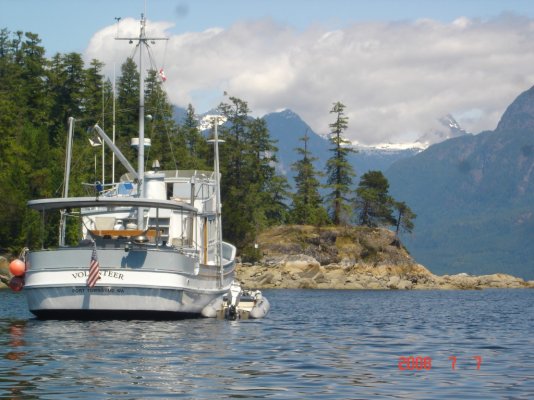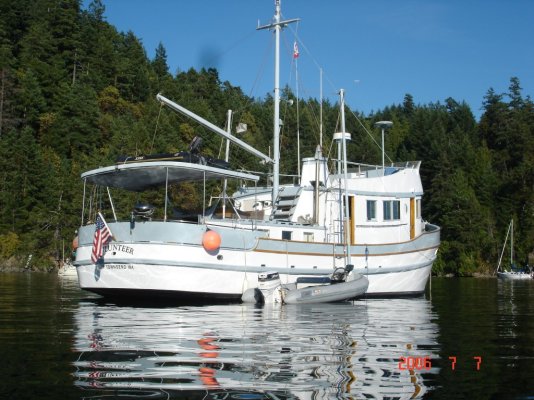marinetrader
Senior Member
- Joined
- Oct 6, 2007
- Messages
- 301
When buying a used trawler, its easy to be turned off by the exterior looks of the boat. Of course, I'm not proposing that it be dismissed. I tell buyers to judge how good the used trawler's been kept up by how she looks. If the exterior finish is all scratched up and the brightwork is in bad shape, I usually find the rest of the boat the same way. It's merely an indicator.
All things considered, a dull exterior isn't a terrible matter either. The gel coat on a used trawler is there for a single reason, to make her look good. It has no other purpose. The gel coats biggest foe is the UV rays of the sun. After 5-10 years exposed to in the Florida sun, almost all gel coats begin to show their age. Not even intense polishing will take the gel coat back to the luster when it was brand new. So when you find a used trawler that has a lack luster outside but everything else is up to par, there is a way to bring her back to her factory-fresh appearance with a little work. How can we do that, by painting her?
There are just a few yachts that are factory painted, Hatteras comes to mind.* When we bought our trawler the Patricia Ann, she was in excellent shape, but her gel coat was dulled and there were a few cosmetic fiberglass nicks here and there. Professional painting of a used trawler or motor yacht is no inexpensive task. You can count on about $1000 a foot to have it professionally done so that was unthinkable.
I started to explore the procedure of doing the painting myself and read as much as I could about what paint to choose and how to do it. At the Ft. Lauderdale Boat Show, I talked with spokespeople from Interlux.* The rep explained to me that both the Interlux make of boat paints and the Awlgrip trademark are very synonymous in formulation and practical application. Interlux, even so, is formulated for the do-it-yourselfer. So my choice was made, Interlux Perfection, two part paint was the way I was going to go.
I'm not going to discuss what the directions read, let me just say that even though operating with two-part paints looks frustrating, its really very easy to do. Just stick to the instructions supplied with each container and you'll get the technique immediately.
I selected the roll and tip method of practical application as spraying in a crowded marina was impossible. Its easy to do once you practice. I practiced on a scrap piece of glass until I had it perfect.* Instructions are provided by Interlux.
Here are a few tips.
<ul>[*]Start your project by dividing the trawler into manageable segments; that way the job will not consume you. I chose the starboard bow pulpit on the Patricia Ann to start my project.[/list]
<ul>[*]Preparing the surface to be painted consumes about 3/4 of the time you will expend on your plan. A bad surface will create a terrible paint job. Start by wiping the gel coat with thinner. This will rid the surface of any silicon or wax that may have been used that will cause your paint to lift after application. [/list]
<ul>[*]The next step, take a small hammer and check the entire surface to be painted, taping lightly to find any voids below the gel coat. When you find them and you will, dig them out with a Dremel tool. You do not want to spend the money and time to do a nice paint job and have voids open up later on.[/list]
<ul>[*]I utilized the West System epoxy with the fairing filler to repair the voids I found.* Follow the directions supplied to make the resin simple to use.* Sand them flat after the restored places have cured. Wash the dust off with water.[/list]
Is this too big of a project?*
<ul>[*]Now we must tape the region that's going to be painted and take off any hardware to cause it go easier.* I applied the 14 day painter's tape available at Lowe's or Home Depot for masking.[/list]
<ul>[*]OK, its time to paint. I used a 4 inch foam roller and the best 2-1/2 inch natural paint brush I could find, also available at Lowe's. Mix only enough paint that you can apply in 2 hours, for me its 1/2 quart. The paint is pricey, about $85.00 a quart and you don't want to be throwing any out.[/list]
<ul>[*]Only use paint when the outside humidity is 75% or less. Be certain there is no risk of rainfall.[/list]
<ul>[*]The paint needs about 5 hrs. to fully harden. Be careful to complete your paint application no later than noon to allow complete drying. If dew settles on your paint, the moisture will turn the high gloss to a dull finish.* I use a window between 10 AM and noon to paint.[/list]
When it was over, it took at least 600 hours to prepare and paint the Patricia Ann. We utilized about 1 gallon of West System resin and 12 quarts of Interlux Perfection to paint two coats on her.
Was it worth it?
Absolutely! She looks great!
If you have been contemplating the painting of your trawler would like to ask me some specific questions, feel free to ask.
All things considered, a dull exterior isn't a terrible matter either. The gel coat on a used trawler is there for a single reason, to make her look good. It has no other purpose. The gel coats biggest foe is the UV rays of the sun. After 5-10 years exposed to in the Florida sun, almost all gel coats begin to show their age. Not even intense polishing will take the gel coat back to the luster when it was brand new. So when you find a used trawler that has a lack luster outside but everything else is up to par, there is a way to bring her back to her factory-fresh appearance with a little work. How can we do that, by painting her?
There are just a few yachts that are factory painted, Hatteras comes to mind.* When we bought our trawler the Patricia Ann, she was in excellent shape, but her gel coat was dulled and there were a few cosmetic fiberglass nicks here and there. Professional painting of a used trawler or motor yacht is no inexpensive task. You can count on about $1000 a foot to have it professionally done so that was unthinkable.
I started to explore the procedure of doing the painting myself and read as much as I could about what paint to choose and how to do it. At the Ft. Lauderdale Boat Show, I talked with spokespeople from Interlux.* The rep explained to me that both the Interlux make of boat paints and the Awlgrip trademark are very synonymous in formulation and practical application. Interlux, even so, is formulated for the do-it-yourselfer. So my choice was made, Interlux Perfection, two part paint was the way I was going to go.
I'm not going to discuss what the directions read, let me just say that even though operating with two-part paints looks frustrating, its really very easy to do. Just stick to the instructions supplied with each container and you'll get the technique immediately.
I selected the roll and tip method of practical application as spraying in a crowded marina was impossible. Its easy to do once you practice. I practiced on a scrap piece of glass until I had it perfect.* Instructions are provided by Interlux.
Here are a few tips.
<ul>[*]Start your project by dividing the trawler into manageable segments; that way the job will not consume you. I chose the starboard bow pulpit on the Patricia Ann to start my project.[/list]
<ul>[*]Preparing the surface to be painted consumes about 3/4 of the time you will expend on your plan. A bad surface will create a terrible paint job. Start by wiping the gel coat with thinner. This will rid the surface of any silicon or wax that may have been used that will cause your paint to lift after application. [/list]
<ul>[*]The next step, take a small hammer and check the entire surface to be painted, taping lightly to find any voids below the gel coat. When you find them and you will, dig them out with a Dremel tool. You do not want to spend the money and time to do a nice paint job and have voids open up later on.[/list]
<ul>[*]I utilized the West System epoxy with the fairing filler to repair the voids I found.* Follow the directions supplied to make the resin simple to use.* Sand them flat after the restored places have cured. Wash the dust off with water.[/list]
Is this too big of a project?*
<ul>[*]Now we must tape the region that's going to be painted and take off any hardware to cause it go easier.* I applied the 14 day painter's tape available at Lowe's or Home Depot for masking.[/list]
<ul>[*]OK, its time to paint. I used a 4 inch foam roller and the best 2-1/2 inch natural paint brush I could find, also available at Lowe's. Mix only enough paint that you can apply in 2 hours, for me its 1/2 quart. The paint is pricey, about $85.00 a quart and you don't want to be throwing any out.[/list]
<ul>[*]Only use paint when the outside humidity is 75% or less. Be certain there is no risk of rainfall.[/list]
<ul>[*]The paint needs about 5 hrs. to fully harden. Be careful to complete your paint application no later than noon to allow complete drying. If dew settles on your paint, the moisture will turn the high gloss to a dull finish.* I use a window between 10 AM and noon to paint.[/list]
When it was over, it took at least 600 hours to prepare and paint the Patricia Ann. We utilized about 1 gallon of West System resin and 12 quarts of Interlux Perfection to paint two coats on her.
Was it worth it?
Absolutely! She looks great!
If you have been contemplating the painting of your trawler would like to ask me some specific questions, feel free to ask.


